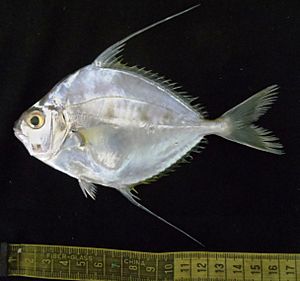Longspine- facts for kids
Quick facts for kids Longspine- |
|
|---|---|
 |
|
| Scientific classification | |
| Synonyms | |
|
The longspine ponyfish (Leiognathus longispinis) is a small fish that lives in both salty ocean water and slightly salty brackish water. You can find it in the Indian Ocean and the western Pacific Ocean. Its home stretches from India, through Malaysia and Indonesia, all the way south to northern Australia, and east to the Philippines and Fiji. It is also sometimes called the Smithurst's ponyfish.
This fish was first described in 1835 by a French scientist named Achille Valenciennes. He studied a fish caught near Waigeo island in New Guinea. Later, in 1886, two other scientists, Ramsay and Ogilby, described the same fish from Papua New Guinea, giving it another name, Leiognathus smithursti.
Contents
What Does the Longspine Ponyfish Look Like?
The longspine ponyfish can grow up to about 16 centimeters (about 6 inches) long. It has a special feature: a noticeably long spine on its back fin (dorsal fin) and another long spine on its belly fin (anal fin). These long spines help to tell it apart from other fish.
Where Does the Longspine Ponyfish Live?
This fish likes to live in waters that are not too deep, usually down to about 40 meters (around 130 feet). It often hangs out near the sea floor, especially in cloudy or murky areas. These murky places are great for finding food and staying hidden from predators.
What Does the Longspine Ponyfish Eat?
The longspine ponyfish is a bottom-feeder, meaning it searches for food on the sea floor. Its diet is quite varied! It eats other small fish, tiny sea creatures called crustaceans (like shrimp and crabs), and even very small worms such as arrow worms and nematodes. It also enjoys shellfish like clams (bivalves) and snails (gastropods).
How Does the Longspine Ponyfish Glow?
Like all members of the ponyfish family, the longspine ponyfish can make its own light. This is called bioluminescence. The light comes from its belly area. Scientists believe this glow helps the fish in a few ways. It might act as camouflage, making it harder for predators to see the fish against the brighter surface water when looking up from below. It could also confuse predators, making them unsure where the fish really is.

